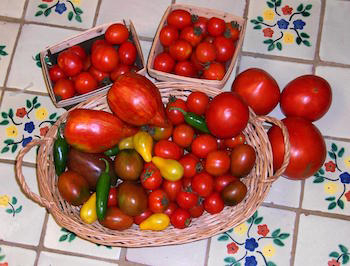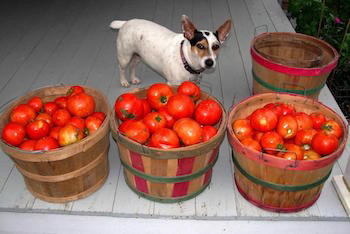
Homegrown tomatoes are an East Texas treat.
January 21, 2023 - Tomato cultivars are ranked into two different categories, depending on their growth habits. Determinant tomatoes (‘BHN 589’, ‘Florida 91’, etc.) form a bush about 36 inches high and set a lot of fruit at the same time. They do well in Texas because, if planted early enough, they set and ripen plenty of tomatoes before the heat of summer causes them to suffer or die. Determinant varieties still need to be staked but don’t have to be picked from a ladder. Indeterminate varieties (‘Better Boy’, most cherry tomatoes, etc.) continue growing taller all summer and have to be staked or caged to keep them from lying on the ground. They set a few fruit, then grow, and then set a few more fruit and grow some more. Production is usually less on indeterminate varieties, especially if planted late, because like all varieties, they stop setting fruit when it’s hot. Some varieties deemed semi-determinant (such as ‘Celebrity’) grow at heights in between.

Homegrown tomatoes are an East Texas treat.
Caged tomatoes produce more higher-quality fruit, and they have fewer disease problems. The best of all supports for tomatoes are sturdy homemade circular cages made from concrete reinforcing wire. They should be 60 inches high and 20 inches in diameter. It is best to tie them to two stakes hammered into the ground to prevent tall plants from toppling over. Cattle panels formed into squares also work well. With caging, suckers do not need to be removed from the base of the plants. All foliage is necessary in Texas to keep the tomato fruit from sunburning.
Tomatoes have a host of insect and disease problems, so be prepared. The abbreviations behind the name on the tag tell you what diseases the variety is resistant to. The more you see listed, the better. They include V (verticillium wilt), F (fusarium wilt), N (nematodes), T (tobacco mosaic virus), A (alternaria stem canker), St (stemphylium gray leaf spot), TSWV (tobacco spotted wilt virus), and TYLC (tomato yellow leaf curl).
The worst pest problem on tomatoes is spider mites. They are tiny spider relatives that feed on the underside of the foliage during hot weather and suck the life out of the plants. Severely infested plants will be covered with fine webbing. Spider mites are very serious and should be sprayed with an appropriately labeled miticide as soon as they appear following all label directions. Seriously infected planted should be removed and destroyed to protect other plants nearby. Damaging insects to watch out for are white flies, leaf-footed plant bugs, and tomato hornworms.
Depending on the variety, tomatoes are generally ready to harvest about seventy to eighty days after transplanting. For eating fresh, harvest the fruit when it is fully colored but still firm. For cooking and canning, you might want to leave them on a bit longer until they’re deep red and give a little when you squeeze them. If critters, cracking, or sunburning is a problem, you can pick them when they first start to turn pink and ripen them at room temperature in a shady location. Of course, green tomatoes can be eaten fried or made into relish.
Some recommended tomato varieties for Texas are Better Boy, BHN 589, Bobcat, Celebrity (an All-American selection and the best for beginners), Florida 91, Harris-Moran 8849, Phoenix, Red Deuce, Red Snapper, Sunbright, Tycoon, and Valley Cat. Most cherry and small fruited varieties do well, and most patio types do not. Unfortunately, heirloom tomatoes and other indeterminate types don’t produce very well in East Texas.
Greg Grant is the Smith County horticulturist for the Texas A&M AgriLife Extension Service. He is author of Texas Fruit and Vegetable Gardening, Heirloom Gardening in the South, and The Rose Rustlers. You can read his “Greg’s Ramblings” blog at arborgate.com, read his “In Greg’s Garden” in each issue of Texas Gardener magazine (texasgardener.com), and follow him on Facebook at “Greg Grant Gardens.” More science-based lawn and gardening information from the Texas A&M AgriLife Extension Service can be found at aggieturf.tamu.edu and aggie-horticulture.tamu.edu.








